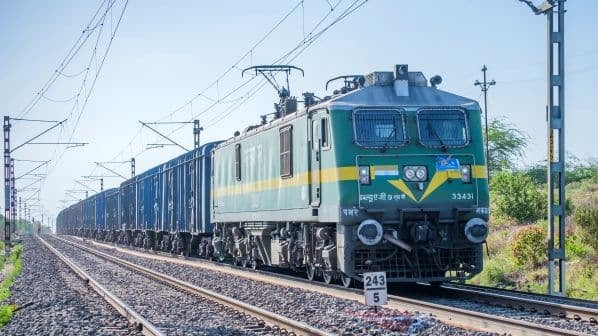ALONG with the incremental introduction of the indigenously-developed 160km/h Vande Bharat EMU on the mainline network, Indian Railways (IR) has two major achievements to show for 2023. First is the completion of the long-awaited 1337km Eastern Dedicated Freight Corridor (EDFC) that connects Ludhiana in Punjab with Sonnagar in Bihar. The second is the buoyant growth in freight traffic seen last year, when IR carried 634.66 million tonnes between April and August, an increase of 1378 tonnes in the same period in 2022.
IR also achieved its highest-ever capital expenditure over these five months, investing Rs 1150bn ($US 13.95bn) in building new lines, track doubling, gauge conversion, the enhancement of passenger amenities and safety projects. Several key projects are now starting to come to life. Trial runs on a 50km section of the Mumbai - Ahmedabad high-speed line are scheduled to start this year and other work on this project is being fast-tracked, with tenders likely to be called during 2024 to supply the first batch of 18 Japanese series E5 Shinkansen trains at an estimated cost of Rs 70bn.
Elsewhere, the 17km priority section of the Regional Rapid Transit System (RRTS) in the National Capital Region was inaugurated on October 20 2023. The remainder of the 82.15km Delhi - Meerut RRTS costing Rs 302.7bn has been making rapid progress and is likely to be completed in June 2025.
Following the collision at Balasore on June 1 2023 that killed 294 passengers, IR has also moved to introduce new electronic signalling systems, with railways minister, Mr Ashwani Vaishnaw, announcing plans to deploy solid-state interlockings across IR’s 68,103 route-km network within the next three years. The programme to roll out the Kavach anti-collision system, a homegrown version of ETCS Level 2, has been accelerated, with contracts awarded for the Delhi - Mumbai and Delhi - Kolkata corridors totalling 3000 route-km.
While IR has justifiably focused on meeting its asset modernisation needs, the company’s declining financial health remains a worry. As pointed out in a report presented by the Comptroller and Auditor General (C&AG) in March 2023, the operating ratio - or proportion of revenue consumed by operating costs - was 107.39% in 2021-22 compared with 97.45% in 2020-21. For the first time in several decades, IR has started to spend more than it earns. During 2021-22, its revenue expenditure increased by 49.3% and the proportion of capital expenditure met from extra-budgetary resources increased by 37.35% due to inadequate generation of internal resources. In the report, the C&AG advised IR to regularly monitor expenditure and budget allocation in order to ensure that funds are properly directed towards their intended purpose.
In the nine years since the current BJP administration came to power, IR’s capital expenditure budget has grown from Rs 539bn in 2013-14 to Rs 2.602 trillion in 2023-24. Gross budgetary support for IR capital expenditure has increased by a factor of eight since 2013-14. Despite this huge infusion of funding, IR’s performance and efficiency does not appear to have been radically transformed for the better. The average speeds of both freight and passenger trains have remained much at the same levels over the last 10 years, while major accidents have continued to happen.
At the same time, ambitious plans to redevelop stations have been announced to great fanfare, but have made little progress. Initiatives to divest IR public-sector undertakings such as Railtel or the Container Corporation of India (Concor) have not come to fruition. Asset monetisation schemes, including plans to sell or lease surplus railway land, have not progressed, and policy reforms to set up an independent rail regulator or introduce a commercial accounting system have not moved forward.
Management reform stalls
The BJP administration has made several bold decisions since coming into office, such as the move to disband IR’s eight existing services and merge them into a single cadre known as the Indian Railways Management Service (IRMS). With this measure, the government intended to do away with the prevailing culture of working in silos, but this change has also had the negative effect of gradually eliminating specialised personnel from the engineering function.
“As a result of this policy of pick and choose, complete chaos has come to prevail in the higher bureaucracy and decision-making has become slow.”
An IR official
The higher echelons of IR management have also been in turmoil following the introduction of new procedures whereby candidates for promotion to the rank of Railway Board member are handpicked and interviewed in person by a panel of ex-IR officials. However, the majority of these panel members did not themselves reach the rank of general manager while at IR. “As a result of this policy of pick and choose, complete chaos has come to prevail in the higher bureaucracy and decision-making has become slow,” an IR official says.
Indeed, senior managers do appear to have been labouring under a climate of indecision during 2023. Examples include the 2500 diesel locomotives in operating condition worth Rs500bn that are now sitting idle, as IR pursues its 100% electrification drive without having worked out a viable programme to phase out or sell its surplus diesel traction. At the same time, more and more Vande Bharat EMUs are flooding onto the network without adequate attention being paid to setting up the many specialised depots needed to maintain and service these new trains.
Apart from his responsibilities as railways minister, Vaishnaw holds two other cabinet portfolios and also shoulders other heavy political responsibilities as a member of the prime minister’s core team. “At a time when big changes are happening, such a situation at the leadership level is not ideal,” an official comments.

